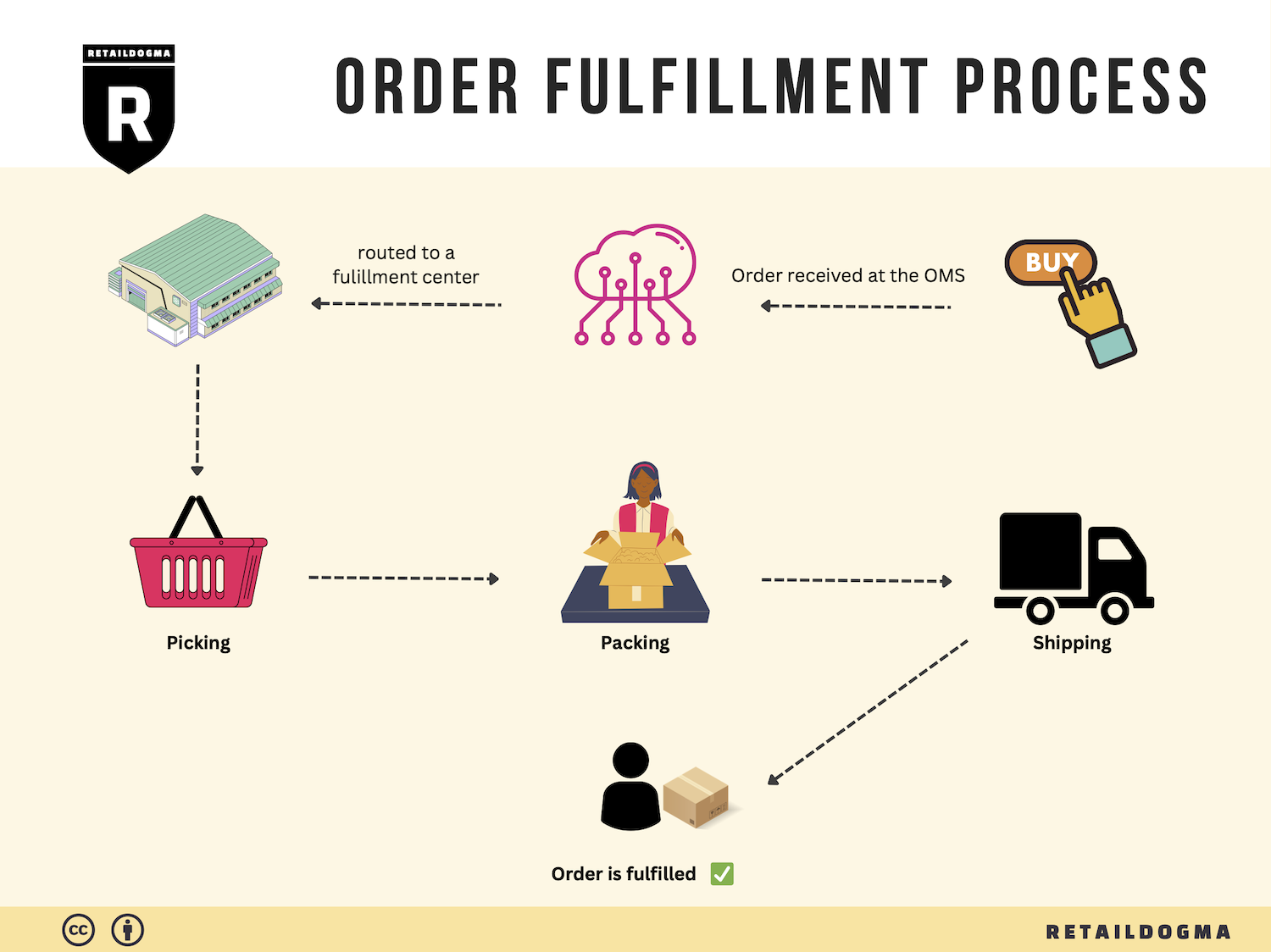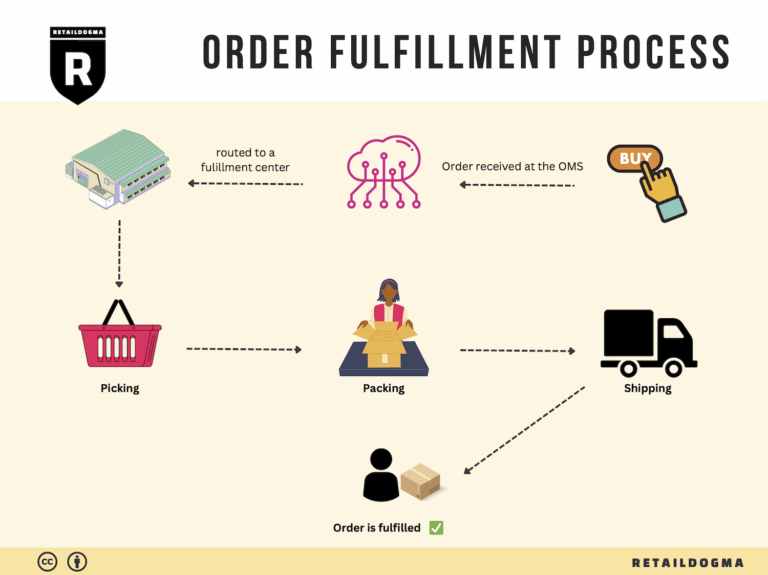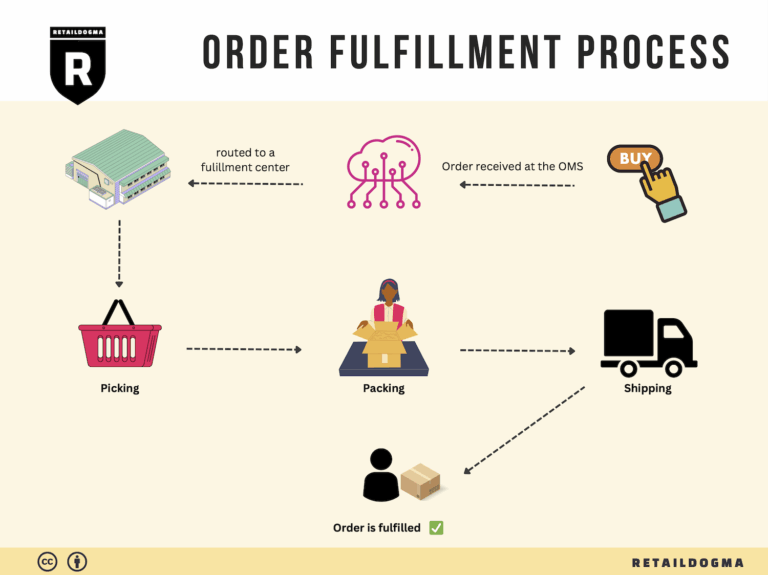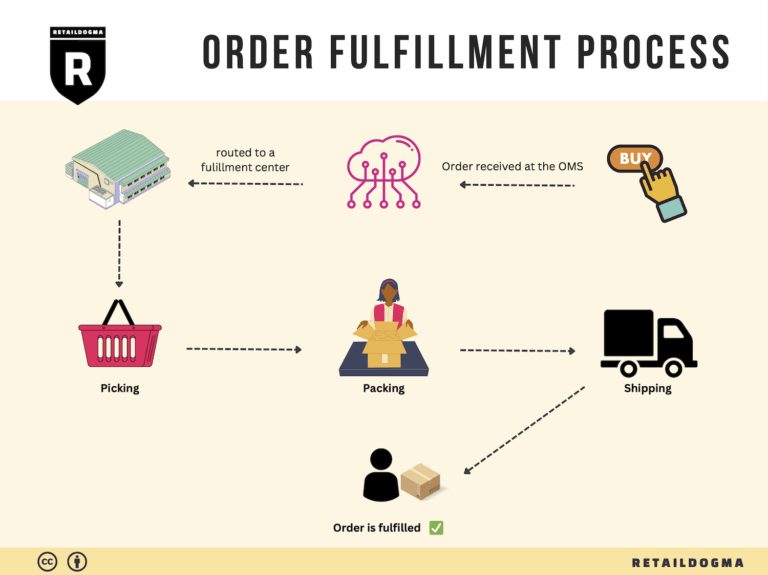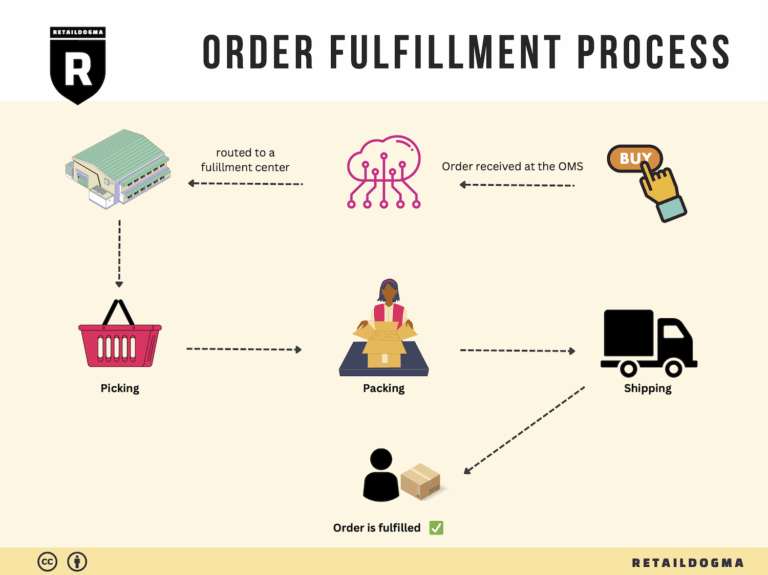How Order Fulfillment Works: A Step-by-Step Guide for Businesses
What is E-commerce Fulfillment? An Introduction for Growing Businesses
Understanding E-commerce Fulfillment
As an e-commerce business owner, you’re likely familiar with the exhilarating yet overwhelming journey of growing your online store. One of the most common pain points for expanding businesses is managing the logistics of packing and shipping orders. The excitement of increased sales can quickly turn into stress when faced with the logistics of fulfilling those orders efficiently. This is where e-commerce fulfillment comes into play.
E-commerce fulfillment is simply the process of getting a product from your inventory to your customer’s doorstep. It encompasses everything from inventory management and order processing to packing and shipping. As your business scales, the complexity of fulfillment increases, and it’s crucial to have a solid strategy in place to meet customer expectations for speed and accuracy.
In this guide, we will explore the various models of fulfillment available to businesses, including Third-Party Logistics (3PL) and Fulfillment by Amazon (FBA). Each model has its own strengths and weaknesses, and understanding these can help you choose the right path for your business.
We will also delve into the core services that fulfillment partners typically provide, such as inventory storage, order picking and packing, custom packaging, and returns management. Knowing what to expect from a fulfillment service can empower you to select a partner that aligns with your operational needs and customer expectations.
Choosing the right fulfillment partner is critical to your success. We will discuss key considerations to keep in mind, such as shipping speed, cost efficiency, scalability, and customer service. These factors play a significant role in ensuring that your logistics operations are not only efficient but also capable of adapting to changing market demands.
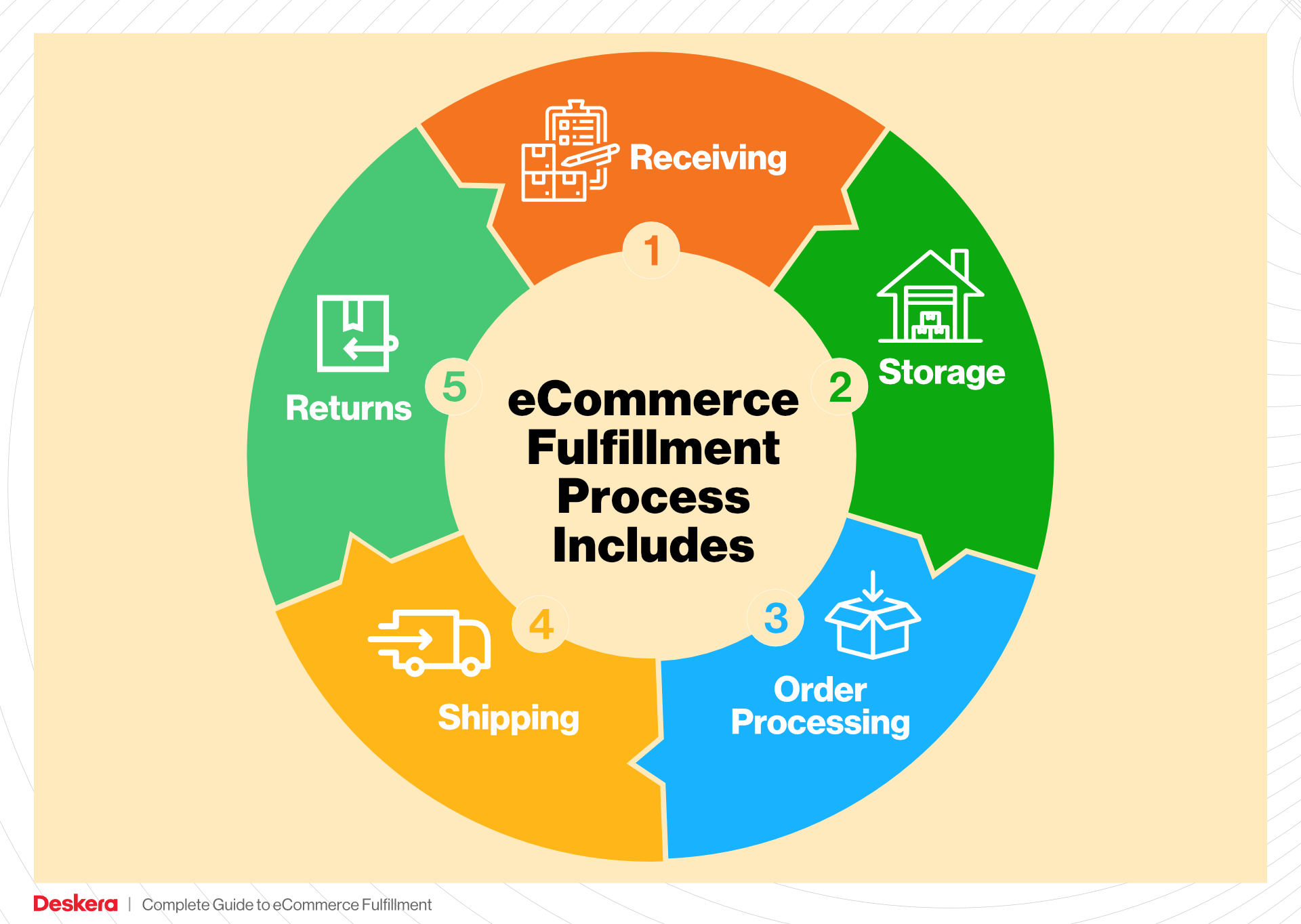
Finally, we will touch on pricing models for fulfillment services, helping you understand the potential costs involved and how to budget effectively.
The ultimate goal of this guide is to empower you to make informed, strategic decisions about your logistics operations. By optimizing your fulfillment process, you can enhance customer satisfaction, streamline your operations, and focus on what you do best: growing your business.
What You’ll Learn In This Guide
- What is E-commerce Fulfillment? An Introduction for Growing Businesses
- The Order Fulfillment Process: From ‘Buy’ Button to Customer’s Door
- Comparing Fulfillment Models: In-House vs. 3PL vs. Dropshipping
- A Deep Dive into Amazon FBA: Pros, Cons, and Who It’s For
- Core Services Offered by Fulfillment Centers
- How to Choose a Fulfillment Partner: A 6-Point Checklist
- Understanding Fulfillment Pricing: A Breakdown of Common Fees
- Frequently Asked Questions (FAQs) about Fulfillment
- Conclusion: Is Outsourcing Fulfillment the Right Move for Your Business?
- Important Disclaimer
The Order Fulfillment Process: From ‘Buy’ Button to Customer’s Door
1. Receiving Inventory
The first step in the order fulfillment process involves receiving inventory from manufacturers or suppliers. This step is crucial as it establishes the foundation for your entire fulfillment operation. Upon arrival, each item must be carefully checked against purchase orders to ensure accuracy. This process often involves recording important details such as the SKU (Stock Keeping Unit), quantity received, and condition of the items.
Efficient receiving practices help minimize discrepancies and reduce the risk of stockouts. Implementing a systematic approach to inventory receiving not only ensures that products are accounted for but also sets the stage for effective inventory management. Accurate documentation and checks during this phase can prevent costly errors down the line, making it a critical component for maintaining an organized supply chain.
2. Warehouse Storage
Once the inventory is received and verified, it needs to be stored properly within the warehouse. This step involves organizing products in a manner that maximizes space while ensuring easy access for order fulfillment. Effective warehouse storage is vital, especially for apparel businesses that often deal with a large variety of SKUs, including different sizes, colors, and styles.
Utilizing inventory management systems to track the location of each item can significantly enhance efficiency. Key terms associated with this step include “bin locations” and “stock rotation,” which refer to the designated spaces where products are stored and the process of ensuring older stock is sold first, respectively. Proper storage not only helps maintain order accuracy but also speeds up the picking process, ultimately improving customer satisfaction.
3. Order Picking
Order picking is the process of selecting items from the warehouse to fulfill customer orders. This step is critical, as accurate picking directly impacts customer satisfaction and operational efficiency. Once an order is placed, a pick list is generated, detailing the items that need to be collected.
There are various picking methods, such as single order picking, batch picking, and zone picking, each suited to different business sizes and order volumes. The goal is to minimize the time spent locating and retrieving products. Implementing technology, such as barcode scanning or pick-to-light systems, can greatly enhance accuracy and speed. Efficient picking ensures that customers receive the correct items quickly, which is essential for maintaining trust and encouraging repeat business.
4. Order Packing
After items have been picked, the next step is order packing. This phase involves carefully packaging the selected items for shipment, ensuring they arrive at the customer’s doorstep in pristine condition. Packaging is not just about protection; it also represents your brand. Custom packaging can enhance the unboxing experience and foster brand loyalty.
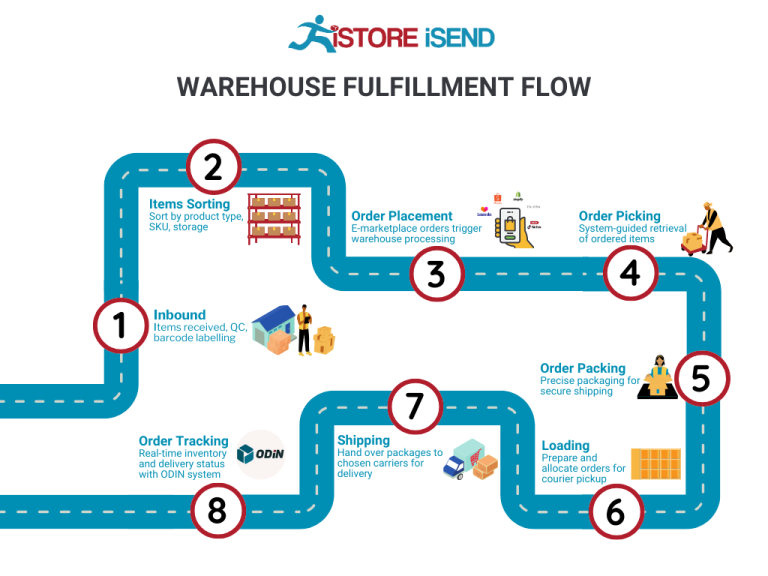
In this step, it’s important to consider factors such as packing materials, box sizes, and weight distribution. Key terms include “packing slips” and “shipping labels,” which accompany the order to provide details and facilitate smooth delivery. Efficient packing processes help reduce shipping costs and return rates, as well-packed items are less likely to be damaged in transit.
5. Shipping & Delivery
The final step in the order fulfillment process is shipping and delivery. Once orders are packed, they are handed over to shipping carriers for delivery to customers. This step is crucial, as it directly affects customer experience and satisfaction. The speed and reliability of shipping can significantly influence a customer’s perception of your brand.
Choosing the right shipping method is essential for balancing cost and speed. Key terms here include “last-mile delivery” and “tracking numbers,” which refer to the final leg of the shipping journey and the unique code that allows customers to track their order, respectively. Effective shipping strategies, such as partnering with multiple carriers or utilizing regional fulfillment centers, can enhance delivery speed and lower shipping costs. By optimizing this final step, businesses can ensure that customers receive their orders promptly, reinforcing a positive brand image and encouraging repeat purchases.
In summary, the order fulfillment process—from receiving inventory to delivering the package—plays a pivotal role in e-commerce success. Each step is interlinked, and understanding their significance can help businesses streamline operations, enhance customer satisfaction, and scale effectively.
Comparing Fulfillment Models: In-House vs. 3PL vs. Dropshipping
Fulfillment Model Comparison
| Model | Who Handles Inventory | Best For (Business Stage) | Key Advantage | Key Disadvantage |
|---|---|---|---|---|
| In-House Fulfillment | The business itself | Established brands with stable sales | Full control over inventory and processes | High overhead costs and resource-intensive |
| Third-Party Logistics (3PL) | 3PL provider | Growing brands looking for scalability | Cost-effective with expert logistics support | Less control over fulfillment processes |
| Dropshipping | Supplier | Startups and niche brands | Low startup costs and minimal risk | Lower profit margins and reliance on suppliers |
In-House Fulfillment
In-house fulfillment involves managing the entire order fulfillment process within your own business. This means that you handle inventory storage, picking, packing, and shipping directly. This model is typically best suited for established brands with stable sales and a robust operational framework. The primary advantage of in-house fulfillment is the level of control it affords; businesses can tailor every aspect of the fulfillment process, from inventory management to shipping methods, ensuring that it aligns perfectly with brand standards and customer expectations. However, this model also comes with significant drawbacks, including high overhead costs associated with warehousing, staffing, and maintaining logistics infrastructure. Additionally, it can be resource-intensive, requiring dedicated personnel and time, which may detract from other critical areas of the business, such as marketing and product development.
Third-Party Logistics (3PL)
Third-party logistics (3PL) involves outsourcing fulfillment operations to specialized providers who manage inventory storage, order processing, and shipping. This model is ideal for growing brands seeking scalability without the burden of managing logistics in-house. A significant advantage of partnering with a 3PL is the cost-effectiveness it offers; these providers often have established relationships with shipping carriers, allowing them to negotiate lower rates that can be passed on to your business. Moreover, 3PLs come equipped with expertise in inventory management and logistics, which can enhance the efficiency of your operations. However, businesses may experience a loss of control over the fulfillment process, which can lead to discrepancies in service quality and fulfillment accuracy. Additionally, choosing the wrong 3PL can result in poor customer service and damage to your brand reputation.
Dropshipping
Dropshipping is a fulfillment model where the retailer does not keep products in stock but instead transfers customer orders and shipment details to a supplier, who then ships the products directly to the customer. This model is particularly advantageous for startups and niche brands, as it requires minimal upfront investment and reduces inventory risk. The low barrier to entry allows entrepreneurs to test various products and markets without committing significant capital to inventory. However, dropshipping comes with its challenges, including lower profit margins due to reliance on suppliers for fulfillment. Additionally, the retailer has limited control over inventory levels and shipping times, which can lead to customer dissatisfaction if the supplier fails to meet expectations. Furthermore, managing customer service and returns can become complicated, as the retailer must coordinate with the supplier to handle issues that arise post-purchase.
In conclusion, each fulfillment model presents unique advantages and challenges that e-commerce businesses must carefully consider based on their operational capacity, growth stage, and customer expectations. By evaluating these factors, brands can select the most appropriate fulfillment strategy that aligns with their long-term objectives and operational capabilities.
A Deep Dive into Amazon FBA: Pros, Cons, and Who It’s For
Understanding Fulfillment by Amazon (FBA)
Fulfillment by Amazon (FBA) is a service offered by Amazon that allows sellers to store their products in Amazon’s fulfillment centers. Amazon then takes care of storage, packaging, shipping, and customer service on behalf of the sellers. This service is particularly attractive to e-commerce businesses looking to streamline their operations and leverage Amazon’s vast logistics network.
How FBA Works
-
Product Listing: Sellers create product listings on Amazon and indicate that they want to use FBA.
-
Inventory Shipment: Sellers send their products to Amazon’s fulfillment centers. Amazon provides guidelines on how to prepare and label products for shipment.
-
Storage: Once the products arrive at the fulfillment center, they are stored until an order is placed.
-
Order Processing: When a customer places an order, Amazon’s systems automatically pick, pack, and ship the product directly to the customer.
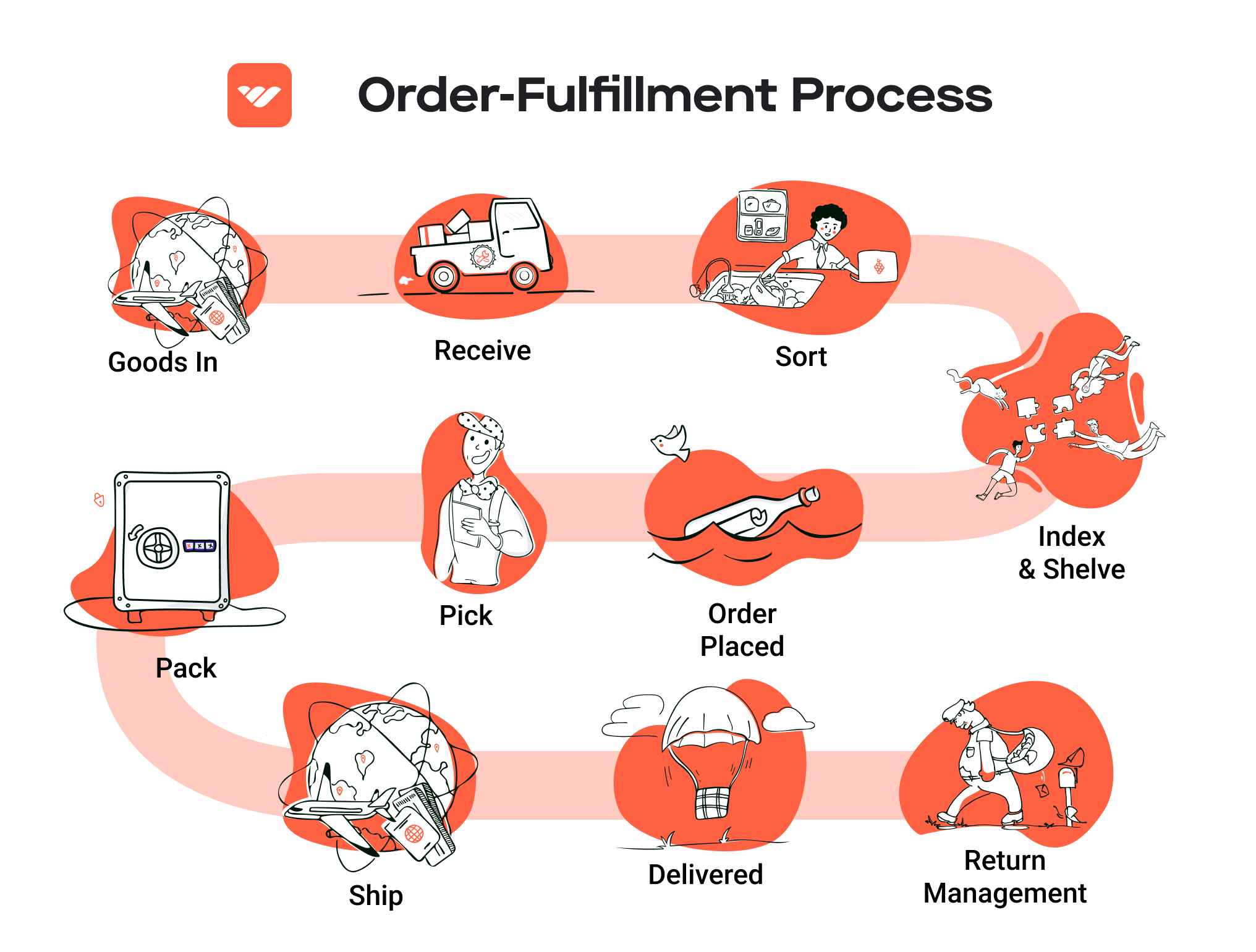
-
Customer Service and Returns: Amazon handles all customer service inquiries and returns for FBA orders, which can significantly reduce the workload for sellers.
-
Payment: Sellers receive payments after Amazon deducts fees for storage and fulfillment services.
Pros of Using FBA
1. Prime Eligibility
Products fulfilled by Amazon are eligible for Amazon Prime, which can significantly increase visibility and sales. Prime members are more likely to purchase products that offer free two-day shipping, making FBA an attractive option for sellers looking to tap into this lucrative customer base.
2. Customer Trust
Amazon is a well-established brand with a reputation for reliability. By using FBA, sellers can benefit from this trust. Customers are often more inclined to purchase products that are fulfilled by Amazon due to the perceived assurance of quality service and ease of returns.
3. Multi-Channel Fulfillment
FBA allows sellers to fulfill orders from other sales channels, such as their own websites or other marketplaces, using Amazon’s logistics network. This can simplify operations and create a more cohesive inventory management system across multiple platforms.
4. Scalability
FBA enables sellers to scale their operations quickly. As demand increases, sellers can send more inventory to Amazon without needing to invest in additional warehousing or staffing. Amazon’s fulfillment centers can accommodate fluctuations in demand, allowing businesses to grow without significant upfront investment.
5. Simplified Logistics
By outsourcing logistics to Amazon, sellers can focus on other aspects of their business, such as marketing and product development. This can lead to increased efficiency and potentially higher profit margins.
Cons of Using FBA
1. High Fees
FBA comes with various fees, including storage fees and fulfillment fees. These costs can add up, especially for sellers with low-margin products or those who do not sell high volumes. Sellers must carefully calculate these fees to ensure profitability.
2. Strict Inventory Rules
Amazon has specific guidelines regarding inventory management, including labeling requirements and storage limits. Sellers must comply with these rules, which can be cumbersome and time-consuming. Non-compliance can result in additional fees or even suspension of seller accounts.
3. Commingling Risks
When using FBA, sellers’ products may be commingled with similar products from other sellers. This can lead to issues with quality control, as there is a risk that a seller’s product could be replaced with a defective item from another seller. This risk can damage a seller’s reputation and lead to customer dissatisfaction.
4. Limited Control Over Shipping
While FBA offers convenience, sellers give up control over the shipping process. Amazon dictates shipping methods and delivery times, which may not always align with a seller’s expectations or customer demands. In some cases, this can lead to delayed shipments and customer complaints.
5. Dependency on Amazon
Using FBA means becoming reliant on Amazon’s platform and policies. Any changes in Amazon’s terms of service, fee structures, or fulfillment processes can directly impact a seller’s business. This dependency can create uncertainty and risk for sellers.
Who is FBA Best For?
Fulfillment by Amazon is best suited for:
-
Small to Medium-Sized Businesses: Those looking to scale quickly without investing heavily in logistics infrastructure can benefit greatly from FBA’s streamlined processes.
-
Sellers with High Sales Volume: Businesses that sell in high volumes can offset the costs associated with FBA fees, making it a more financially viable option.
-
Brands Seeking Prime Access: Sellers wanting to tap into the Prime customer base can significantly boost their visibility and sales through FBA.
-
E-commerce Entrepreneurs Focused on Growth: Businesses that want to focus their efforts on marketing, product development, and customer engagement rather than logistics will find FBA appealing.
-
Multi-Channel Sellers: Brands that sell across different platforms can streamline their logistics with FBA, allowing for a more efficient inventory management system.
In conclusion, Fulfillment by Amazon offers a powerful solution for e-commerce sellers looking to leverage Amazon’s vast logistics network. While it comes with its own set of challenges, the potential benefits often outweigh the downsides for many businesses, especially those poised for growth in the competitive online marketplace.
Core Services Offered by Fulfillment Centers
Inventory Management & Warehousing
Inventory management and warehousing are foundational services offered by fulfillment centers, designed to streamline the storage and tracking of products. This service encompasses the systematic organization of stock, ensuring that products are stored efficiently and are easily accessible when orders are placed.
What It Is: Fulfillment centers provide secure, climate-controlled storage facilities where e-commerce businesses can house their inventory. They utilize advanced inventory management systems that integrate with e-commerce platforms to track stock levels in real-time, manage SKU variations, and provide automated alerts for low inventory.
Benefits to E-Commerce Businesses: Effective inventory management minimizes the risk of stockouts or overstock situations, which can lead to lost sales or increased holding costs, respectively. By maintaining optimal inventory levels, businesses can respond swiftly to customer demand, ensuring that popular items are always available. Additionally, secure warehousing reduces the risk of theft or damage, protecting the business’s assets. This allows e-commerce entrepreneurs to focus on growth strategies, marketing, and customer engagement rather than the logistical challenges of inventory handling.
Pick and Pack Services
Pick and pack services are crucial for ensuring that orders are fulfilled accurately and efficiently. This service involves selecting the correct items from the warehouse inventory, packing them according to the business’s specifications, and preparing them for shipment.
What It Is: When a customer places an order, fulfillment centers receive the notification and initiate the pick and pack process. Trained staff or automated systems locate the ordered items, package them securely, and label them for shipment. This process may include custom branding options, such as branded boxes and personalized packing slips, to enhance the customer experience.
Benefits to E-Commerce Businesses: Speed and accuracy are paramount in e-commerce, and effective pick and pack services significantly enhance both. Rapid order processing leads to faster shipping times, which is crucial for customer satisfaction and repeat purchases. Moreover, a meticulous picking process minimizes errors, reducing the likelihood of returns due to incorrect items being shipped. This not only saves costs associated with returns but also strengthens customer trust in the brand.
Kitting and Assembly
Kitting and assembly services allow businesses to bundle multiple products into a single package or create custom kits tailored to specific customer needs. This service is particularly useful for apparel brands that may offer coordinated outfits or promotional bundles.
What It Is: Kitting involves the assembly of various individual items into a single package, which could include clothing items, accessories, or promotional materials. This process may also include labeling and special packaging, ensuring that the final product meets the branding and quality standards of the business.
Benefits to E-Commerce Businesses: Kitting and assembly services can significantly enhance product offerings and create unique selling propositions. By offering bundled products, businesses can increase average order value and encourage upsells. Additionally, this service saves time and labor costs, as fulfillment centers handle the assembly process, allowing e-commerce teams to concentrate on product development and marketing strategies. Customized kits also provide a personal touch that can improve customer satisfaction and brand loyalty.
Returns Management (Reverse Logistics)
Returns management, often referred to as reverse logistics, is a critical service for e-commerce businesses, particularly in the apparel sector, where return rates can be higher than average. This service encompasses the entire process of handling product returns from customers back to the fulfillment center.
What It Is: Fulfillment centers manage the return process, including receiving returned items, inspecting their condition, and determining the appropriate course of action—whether to restock, repair, or dispose of the items. They also handle customer communications regarding returns, ensuring a smooth and hassle-free experience for the customer.
Benefits to E-Commerce Businesses: An efficient returns management system is essential for maintaining customer satisfaction and trust. A seamless return process can turn a potentially negative experience into a positive one, encouraging customers to shop again. Additionally, by handling returns professionally, fulfillment centers help businesses recover valuable inventory quickly, minimizing losses and enabling better inventory control. This service also allows e-commerce businesses to develop more favorable return policies, which can be a significant competitive advantage in attracting customers.
In conclusion, partnering with a fulfillment center that offers comprehensive services in inventory management, pick and pack, kitting, and returns management can significantly enhance an e-commerce business’s operational efficiency. These services not only streamline logistics but also provide a foundation for scaling operations, improving customer satisfaction, and ultimately driving sales growth.
How to Choose a Fulfillment Partner: A 6-Point Checklist
Location & Warehouse Network
Importance:
The geographical location of your fulfillment partner’s warehouses is crucial. A well-placed warehouse can significantly reduce shipping times and costs, enhancing customer satisfaction. For apparel businesses, proximity to major shipping routes and urban centers can also optimize logistics.
Questions to Ask:
– Where are your warehouses located? How many do you have?
– Can you provide shipping estimates to my primary customer locations?
– How do you manage inventory across different warehouse locations?
– What shipping carriers do you partner with, and how do they affect delivery times?
Technology & Integrations
Importance:
In today’s digital landscape, seamless technology integration is vital for efficient operations. A fulfillment partner should offer robust software that integrates with your e-commerce platform, allowing for real-time inventory tracking, order management, and analytics.
Questions to Ask:
– What technology do you use for order fulfillment, and how does it integrate with my existing systems?
– Can you provide real-time updates on inventory levels and order statuses?
– Do you have a user-friendly dashboard for tracking orders and returns?
– How frequently do you update your technology and what is your approach to data security?
Specializations (e.g., cold storage, oversized items)
Importance:
Your apparel business may have unique requirements, such as handling specific types of products or special storage conditions. Understanding your partner’s specializations can ensure they can meet your needs without compromising service quality.
Questions to Ask:
– What specific types of apparel or accessories do you specialize in handling?
– Do you offer specialized services like custom packaging or cold storage?
– How do you manage items with varying storage needs, such as oversized or delicate garments?
– Can you accommodate seasonal spikes in demand or unique product lines?
Scalability & Capacity
Importance:
As your business grows, so too will your fulfillment needs. Your partner must have the capacity to scale operations without disrupting service. A flexible partner can adapt to changes in order volume, whether due to seasonal fluctuations or rapid growth.
Questions to Ask:
– What is your current capacity for handling orders, and how do you plan to scale as my business grows?
– Can you provide examples of how you’ve adapted to past clients’ growth?
– How do you manage fluctuations in order volume, especially during peak seasons?
– What strategies do you have in place for maintaining service quality during scaling?
Pricing and Contracts
Importance:
Understanding the pricing structure and contract terms is essential for budgeting and financial planning. A transparent pricing model will help avoid unexpected costs and ensure that the partnership remains profitable as your business scales.
Questions to Ask:
– Can you provide a detailed breakdown of your pricing model, including storage fees, pick and pack fees, and shipping costs?
– Are there any additional fees I should be aware of, such as for returns or special requests?
– What are the terms of your contract, and how flexible are they regarding changes in my business?
– Do you offer pay-as-you-go options or require long-term commitments?
Customer Support & Reviews
Importance:
Excellent customer support is a hallmark of a reliable fulfillment partner. Their responsiveness can make a significant difference when issues arise, such as shipping errors or inventory discrepancies. Additionally, reviews from other clients can provide insights into the partner’s reliability and service quality.
Questions to Ask:
– What level of customer support do you provide, and what are your hours of operation?
– How quickly can I expect a response to inquiries or issues?
– Can you share references or testimonials from other apparel brands you’ve worked with?
– What is your process for handling fulfillment errors or customer complaints?
Conclusion
Choosing the right fulfillment partner is a critical decision for your apparel business. By carefully evaluating potential partners against this checklist, you can ensure that you select a provider that not only meets your current needs but also supports your growth and success in the competitive e-commerce landscape.
Understanding Fulfillment Pricing: A Breakdown of Common Fees
Initial Setup Fees
When engaging with a fulfillment service for the first time, businesses often encounter initial setup fees. These charges typically cover the administrative costs involved in integrating your e-commerce platform with the fulfillment center’s systems, as well as the initial onboarding process. Setup fees can vary significantly based on the complexity of your operation and the technology needed for integration.
Some fulfillment providers may offer promotional periods where they waive these fees, especially for new clients or startups. It’s essential to inquire about any setup fees upfront, as understanding these costs can help you budget effectively when starting your partnership.
Receiving Fees
Receiving fees are charged when the fulfillment center accepts and processes incoming inventory. This fee generally covers the labor and resources needed to unload, inspect, and store your products. The calculation of receiving fees can vary based on several factors, such as:
- Volume of Inventory: Larger shipments may incur lower per-unit costs due to economies of scale.
- Complexity of the Inventory: If your products require special handling, such as fragile items or apparel with multiple SKUs, this may result in higher fees.
Businesses should anticipate these costs when planning inventory shipments and ensure that they communicate any specific requirements to their fulfillment provider to avoid unexpected charges.
Storage Fees (per pallet/bin)
Storage fees are charged for the space your inventory occupies in the fulfillment center. These fees can be calculated on a per-pallet or per-bin basis, depending on how the warehouse organizes its storage. Understanding the different pricing structures can help businesses manage their costs effectively:
- Per Pallet Fees: This is a common model where fees are assessed based on the number of pallets your inventory occupies. This method is ideal for bulk items or larger clothing lines.
- Per Bin Fees: This model charges based on the number of bins your products fill. This can be more appropriate for smaller items or a diverse range of apparel, allowing for better organization and more efficient picking processes.
Additionally, many fulfillment centers implement tiered pricing, where the storage cost decreases as your inventory volume increases. Be sure to clarify the specifics of their storage pricing to avoid surprises.
Pick & Pack Fees (per item/order)
Pick and pack fees are incurred each time an order is processed. These fees cover the labor involved in picking the items from storage, packing them securely, and preparing them for shipment. Typically, fulfillment centers charge on a per-item or per-order basis. Here’s how these fees can be structured:
- Per Item Fees: This model charges for each item picked and packed. It’s suitable for businesses with numerous single-item orders.
- Per Order Fees: Some providers may offer a flat fee for each order, regardless of the number of items. This is beneficial for businesses with multiple items per order, as it can simplify budgeting.
To minimize these fees, businesses can work on optimizing their order sizes and the efficiency of their inventory layout. Understanding the nuances of pick and pack pricing can significantly affect your overall fulfillment costs.
Shipping Fees
Shipping fees are often the most significant cost associated with fulfillment services. These fees can vary widely based on several factors, including:
- Shipping Method: Ground, air, and international shipping all come with different costs. Businesses should consider the balance between speed and cost-effectiveness.
- Destination: Shipping fees increase with distance. Partnering with fulfillment centers strategically located near your customer base can help reduce these costs.
- Volume Discounts: Many fulfillment providers negotiate bulk shipping rates with carriers, which can lower costs for your business.
It’s crucial to review your shipping options and negotiate terms with your fulfillment partner. Many providers offer flexible shipping solutions tailored to your needs, which can lead to significant savings.
Tips for Getting an Accurate Quote
-
Be Transparent: Provide your fulfillment partner with detailed information about your product dimensions, order volume, and shipping requirements. The more they know, the more accurate their quote will be.
-
Ask About All Fees: Ensure that you inquire about all potential fees, including hidden costs such as returns management and additional service fees.
-
Compare Multiple Providers: Don’t settle for the first quote you receive. Compare pricing and services from several fulfillment centers to find the best fit for your business.
-
Consider Long-Term Partnerships: Some fulfillment centers may offer discounts for longer commitments or higher volume agreements. Discuss potential long-term arrangements to save costs.
-
Request Custom Quotes: Many fulfillment services provide the option for tailored quotes based on specific business needs. Don’t hesitate to ask for this if your business has unique requirements.
By understanding these common fees and engaging proactively with your fulfillment provider, you can establish a more predictable and manageable fulfillment budget, allowing you to focus on scaling your e-commerce business.
Frequently Asked Questions (FAQs) about Fulfillment
1. What is apparel fulfillment?
Apparel fulfillment refers to the entire process of storing, packing, and shipping clothing items on behalf of a retailer. This process is typically handled by third-party logistics providers (3PLs) or specialized fulfillment centers that manage inventory and logistics, allowing businesses to concentrate on design, marketing, and customer service.
2. What is a 3PL?
A 3PL, or third-party logistics provider, is a company that offers logistics services to businesses. This can include warehousing, inventory management, order fulfillment, and shipping. By partnering with a 3PL, e-commerce brands can streamline their operations and focus on growing their business without the overhead of managing logistics in-house.
3. How does apparel fulfillment work?
Apparel fulfillment typically involves several steps:
1. Inventory Storage: Your products are stored securely in a fulfillment center.
2. Order Notification: When a customer places an order, the fulfillment center is notified.
3. Picking and Packing: The fulfillment team picks the ordered items from inventory, packs them according to your specifications, and prepares them for shipment.
4. Shipping: The packaged order is shipped directly to the customer, often using the most cost-effective and efficient shipping method.
4. What’s the difference between a warehouse and a fulfillment center?
A warehouse is primarily a storage facility where goods are kept until they are needed. In contrast, a fulfillment center is a specialized warehouse that also handles the processes of picking, packing, and shipping orders. Fulfillment centers are designed to expedite order processing and improve delivery times, catering specifically to e-commerce businesses.
5. How much do fulfillment services cost?
The cost of fulfillment services can vary widely based on several factors, including the volume of orders, the types of products being fulfilled, storage space required, and the specific services offered. Many fulfillment centers operate on a pay-as-you-go model, charging fees for storage, picking, packing, and shipping. It’s essential to request quotes from different providers to compare costs and find a service that fits your budget.
6. What should I look for in an apparel fulfillment partner?
When selecting an apparel fulfillment partner, consider the following:
– Experience and Expertise: Look for a provider with a proven track record in apparel fulfillment.
– Technology Integration: Ensure they offer easy integration with your e-commerce platform for seamless order processing.
– Shipping Options: Evaluate their shipping methods and costs to ensure they can meet your delivery expectations.
– Customer Service: Choose a partner that offers responsive support and can handle any issues that may arise efficiently.
7. How can fulfillment services help reduce return rates?
Effective fulfillment services can minimize return rates by ensuring accurate order processing. By implementing thorough inventory management systems and quality control checks, fulfillment centers can reduce the likelihood of sending incorrect items. Additionally, clear product descriptions and sizing guides can help customers make informed purchasing decisions, leading to fewer returns.
8. Can fulfillment services accommodate seasonal fluctuations in demand?
Yes, reputable fulfillment services are designed to be scalable, allowing businesses to adjust their operations based on demand fluctuations. During peak seasons, such as holidays, fulfillment centers can ramp up staffing and resources to handle increased order volumes efficiently. Conversely, during slower periods, they can scale down operations to reduce costs.
9. How does inventory management work in apparel fulfillment?
Inventory management in apparel fulfillment involves tracking stock levels, managing SKUs, and ensuring that items are available for order fulfillment. Many fulfillment centers use sophisticated software that integrates with your e-commerce platform, providing real-time updates on inventory levels, automated alerts for low stock, and insights to help you make informed purchasing decisions.
10. What are the benefits of custom packaging in apparel fulfillment?
Custom packaging can enhance your brand’s identity and improve customer experience. Studies show that personalized packaging can increase customer loyalty and the likelihood of repeat purchases. Additionally, custom packaging can help reduce damage during shipping and make a positive first impression when customers receive their orders, contributing to overall satisfaction with your brand.
Conclusion: Is Outsourcing Fulfillment the Right Move for Your Business?
Key Benefits of Outsourcing Fulfillment
Outsourcing your apparel fulfillment can significantly enhance your business operations, allowing you to focus on what you do best—designing and marketing your products. One of the primary advantages is time savings; by partnering with a fulfillment service, you can delegate the complex and time-consuming tasks of inventory management, order processing, and shipping logistics. This delegation enables you to redirect your efforts toward strategic growth initiatives and customer engagement.
Scalability is another critical benefit. As your business grows, so do your fulfillment needs. A reliable fulfillment partner can easily adapt to your evolving requirements, accommodating fluctuations in order volume without compromising service quality. This flexibility is particularly beneficial for apparel brands, which often experience seasonal spikes in demand. By leveraging the expertise of a fulfillment provider, you can ensure that your operations are equipped to handle growth seamlessly.
Moreover, choosing the right fulfillment partner brings additional expertise to your business. Established fulfillment centers understand the nuances of apparel logistics, from managing diverse SKUs to implementing efficient returns management processes. Their experience can help streamline your operations, reducing errors and enhancing customer satisfaction.
The Importance of the Right Partner
However, not all fulfillment services are created equal. Selecting the right partner is crucial for your business’s success and growth. Take the time to assess potential providers based on their service offerings, technology capabilities, and customer support. A well-aligned partner can be a game-changer, providing the infrastructure and knowledge necessary to elevate your brand.
Call to Action
To determine if outsourcing fulfillment is the right move for your business, conduct an audit of your current shipping processes. Identify bottlenecks, assess your scalability needs, and evaluate how much time you are currently spending on fulfillment-related tasks. This analysis will help you understand whether partnering with a fulfillment service could enhance your operational efficiency and support your growth strategy. Make the informed choice that best aligns with your business goals and customer expectations.
Important Disclaimer
⚠️ Important Disclaimer
The information in this guide is for educational purposes. Fulfillment services, pricing, and platform features change frequently. Always conduct your own due diligence and consult with providers directly before making business decisions.
